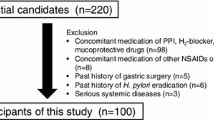Abstract
Objective: Intragastric pH-metry is widely used to evaluate the efficacy of antisecretory drugs, but statistical interpretation of the measurements has not yet been standardised.
Methods:
The effects of single morning (N = 9) or evening (N = 7) doses of the H2-receptor antagonist famotidine, 20 mg (QUAMATELR, Gedeon Richter, Hungary) were compared by 24-hour intragastric pH-metry in hyperacid patients, in a prospective, controlled clinicopharmacological study. Intragastric pH was repeatedly measured with or without administration of famotidine, and {1} the minute to minute median pH values were calculated.
Results:
{2} Both treatments significantly reduced gastric acidity according to the “traditional” parameters of the time at pH ≥ 3, or median pH in the first 12 hours. Famotidine treatment in the evening was more effective than in the morning (634 vs 463 min or 5.22 vs 3.10). The morning and evening treatment groups did not differ from each other in these parameters when compared on the days without famotidine. {3} After demonstration of the significant differences between the treatment vs control days, and morning vs evening administrations we applied the Pattern Recognition by Independent Multicategory Analysis (PRIMA) method to select the most sensitive parameters for evaluation of the H2-receptor antagonist drug effect. The PRIMA method was developed to determine the sensitivity of each statistical parameter analysed in a comparison of different groups (discriminating power), and to determine the separability of groups using several parameters concomitantly (separation of groups). The mean pH, the period at pH ≥ 3, and the duration of pH-increase ≥ 1 on the day of treatment compared to the control day were found to be the most sensitive parameters both in demonstrating H2-receptor antagonist effect and in differentiation of morning and evening doses. {4} High separability of morning and evening treatment groups was achieved using these three parameters concomitantly according to the PRIMA method.
Conclusion:
This method may be of value in other clinical or clinicopharmacological trials to standardise the statistical analysis of data by selection of the most sensitive parameters for comparison of the patient groups. In subsequent studies it might also increase the sensitivity of discrimination by concomitant analysis of different parameters using the smallest appropriate number of patients.
Similar content being viewed by others
Author information
Authors and Affiliations
Additional information
Received: 22 July 1995/Accepted in revised form: 23 February 1996
Rights and permissions
About this article
Cite this article
Hunyady, B., Juricskay, I., Nagy, L. et al. Statistical interpretation of the antisecretory effect of famotidine measured by intragastric pH-metry. E J Clin Pharmacol 50, 449–456 (1996). https://doi.org/10.1007/s002280050139
Issue Date:
DOI: https://doi.org/10.1007/s002280050139




